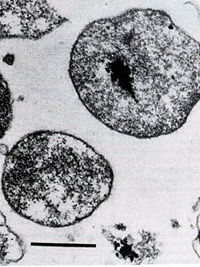Thermoplasma acidophilum: Difference between revisions
Jump to navigation
Jump to search
imported>Victor Wong No edit summary |
imported>Victor Wong No edit summary |
||
| Line 17: | Line 17: | ||
==Description and significance== | ==Description and significance== | ||
T.Acidophilum is a gram negative bacterium that varies from a spherical to filamentous structure. They can survive harsh conditions such as extremely low pH levels (0.5-4), and high temperatures (33-67 °C). | |||
==Genome structure== | ==Genome structure== | ||
Revision as of 16:29, 22 April 2009
For the course duration, the article is closed to outside editing. Of course you can always leave comments on the discussion page. The anticipated date of course completion is May 21, 2009. One month after that date at the latest, this notice shall be removed. Besides, many other Citizendium articles welcome your collaboration! |
| "Thermoplasma Acidophilum" | ||||||||||||||
|---|---|---|---|---|---|---|---|---|---|---|---|---|---|---|
 | ||||||||||||||
| Scientific classification | ||||||||||||||
| ||||||||||||||
| Binomial name | ||||||||||||||
| "Thermoplasma Acidophilum" |
Description and significance
T.Acidophilum is a gram negative bacterium that varies from a spherical to filamentous structure. They can survive harsh conditions such as extremely low pH levels (0.5-4), and high temperatures (33-67 °C).